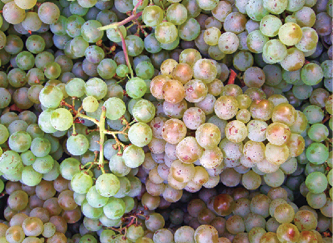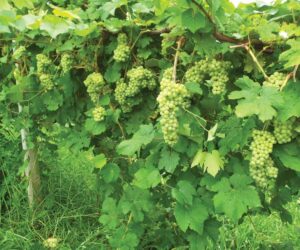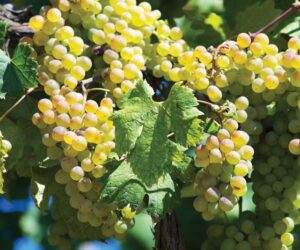 From time to time, we come across a grape that suffers from an identity crisis. In the case presented here with Pinot Blanc, we have a situation of genetic identity, mistaken identity, and stature identity. Pinot Blanc is a grape that has been around for a long while, but never really had its chance to get even 15 minutes of fame.
From time to time, we come across a grape that suffers from an identity crisis. In the case presented here with Pinot Blanc, we have a situation of genetic identity, mistaken identity, and stature identity. Pinot Blanc is a grape that has been around for a long while, but never really had its chance to get even 15 minutes of fame.
Dissecting the name, the root “Pinot” comes from the French noun for “pine” because the fruit clusters take on the appearance of a pinecone, with fairly small berries on a tight cluster. “Blanc” is the French word for “white.” The clusters are typical of white grapes, starting out as hard green berries and after veraison, taking on a golden hue.
To understand Pinot Blanc and its genetic identity, (and also Pinot Gris, see the “Varietal Focus” column from August-September 2013) one must first understand Pinot Noir, the namesake red grape of France’s Côte d’Or in Burgundy. Pinot Blanc is a mutant of Pinot Noir. Mutations in nature are random aberrations of the genetic code being read from chromosomes a little differently than originally planned. Mutations happen to every species on earth, some that benefit the organism, such as habitat adaptation, and some that are serious enough to result in a situation where the organism faces certain death. Fortunately, the mutation for Pinot Noir is not as extreme.
The origins of the mutation and why Pinot Noir has mutated in this way is the result of what are referred to as “jumping genes.” Strictly defined, a jumping gene is a gene or set of genes capable of inserting copies of itself into other DNA sites within the same cell. In the case here, the gene inserting itself is for the end color of the grape. Because of the common nature of this happening in Pinot Noir, a vineyard planted to Pinot Noir will have a certain amount of the Gris and Blanc versions as well. The persistence of any vine with a particular color of fruit is based on selection of the shoots producing that fruit color and selecting against the other versions. In this case, to develop a vineyard of Pinot Blanc, one would take cuttings of the Blanc version and plant a new vineyard with these cuttings. Initially, the field would be entirely Pinot Blanc, however, over time, Pinot Noir and Pinot Gris clusters would start to show up on the plants as well. Unknown to the science at the time, these genetic mutations were first noticed hundreds of years ago in Burgundy, France, where the mutants grew side by side, and sometimes within the same plant as Pinot Noir.
The other Pinot Noir mutant, Pinot Gris, is different from Pinot Blanc in that with Gris the grapes have red hues to the berries. At maturity, the berries take on a rose color and sometimes even darker hues.
There are 96 synonyms of the grape Pinot Blanc, such as Klevner, Auxerrois, Pinot Bianco, and Weissburgunder, to name a few of the most notable. The synonyms take on a regional name with Klevner and Auxerrois from Alsace, Pinot Bianco from Italy and Weissbur-gunder from Germany. The use of the name Auxerrois can be confusing in that Auxerrois refers to a region in France, but lends its name to several grape varieties. The other synonyms for Pinot Blanc are variations on the theme such as Burgunder Blanc or Weiss Klevner. It is very common in a wine region as old as Europe’s that the actual varietal name is less important than the region in which it is grown.
In France, where the grape originated, it accounts for less than half of a percent of the total grape area. Alsace, in northeastern France along the Rhine River, and its border with Germany, is the region where it holds on as one of the more common grapes. It is found in still white wine blends, often blended with Sylvaner, and it is the main grape that is used in Crémant d’Alsace, or the sparkling wine of Alsace. Sparkling wines made in France outside of the Champagne region are referred to as Crémant. Of notable interest is Pinot Blanc used to be one of the principle varieties in Champagne, but that dis-tinction now belongs to Chardonnay, Pinot Noir and Pinot Meunier, depending on style. While still permitted to be included in Champagne, it is rare that it is with only a few producers still doing so.
Historically in Burgundy, Pinot Blanc was blended with Pinot Noir to lighten the wine, but today it is against appellation d’origine contrôlée (AOC) regulations for the region. Up to 20% of many producers’ wines in Burgundy in the 18th century contained either Pinot Gris or Pinot Blanc. Today, with the emphasis on deeply colored, rich wines, the AOC has not permitted their inclusion except if it is in the oldest vineyard of the region dating back pre-1930s.
Across the Rhine River, where it is known as Weissburgunder (you will also see it referenced as Weißburgunder, where the Eszett symbol “ß” is the German version of double “s”), it is grown from the Baden region and points south. This region is essentially on the opposite side of the Rhine River Valley from Alsace, and growing conditions are very similar. The total area in Germany planted to Pinot Blanc is less than 5% of all vineyards combined. Müller-Thurgau and Riesling are the prominent white grapes there, combined to cover about 35% of the vineyards in Germany. The remaining 30 or so varieties comprise about 60 percent, with Spätburgunder (also known as Pinot Noir), heading the list at about 15%, and the rest at about 5% or less. So Pinot Blanc is a very minor player in Germany as well.
Outside of Europe, Pinot Blanc is also overshadowed by other varieties. In California, only 444 acres were reported to be in production in 2011. To the north in Oregon, only about 160 acres were planted.
Originally certified at the Foundation Plant Services at UC-Davis, the cuttings were distributed to growers and wineries as Pinot Blanc. Then in 1980, along came Pierre Galet, who is considered somewhat of a God in the world of grape vine ampelography. Dr. Galet pointed out to university officials that the Pinot Blanc they were distributing was not Pinot Blanc at all, rather it was a similar looking variety by the name of Melon de Bourgogne. In the days before DNA testing of varieties to determine their type, everyone depended on the skill sets of ampelographers. A few years later, the university acknowledged the mistake, and notified the growers. Many growers continued to produce the wine as Pinot Blanc, rather than Melon. Their rationale was that Pinot Blanc, as a name, was more marketable than Melon, which is pronounced “Me-lon,” but it looks like “Mel-on,” as in the fruit. In 1996 the Tax and Trade Bureau (TTB), formerly known as the Bureau of Alcohol, Tobacco and Firearms, issued a ruling stating that the wines must be labeled as Melon. I know of only one winery in Oregon that embraced the change. They produced an outstanding example of Pinot Blanc, rather, Melon, and capitalized on the mistake in their marketing. I visited the winery a few years back and they boasted heavily on their accomplishment. They had an argument indeed; if we called it Pinot Blanc and you liked it, why wouldn’t you like it if it was called Melon. In the end it is all marketing, and I wish it were just that easy.
Morphologically, Pinot Blanc looks a lot like Chardonnay in the vineyard, but it makes a distinctly different wine due to its generally higher acid levels.
As with many grape varieties, a myriad of different styles are possible based on region. That said, producers often make the wine to reflect regional style. The grape presents generally fruity attributes of peach and pear. In cooler regions, it is said to present itself with hints of minerality. Minerality, while used as a wine descriptor for some time, has only been recently defined as an integrated concept, defined as low in fruity characteristics, more “citrus” than “apricot,” with little to no oak. In some personal communications with my colleagues, someone suggested a salty undertone as well.
Given Pinot Blanc’s generally simple style, it also presents itself to be a good wine that could be enhanced with some subtle oak tones. Some winemakers will oak age the wines to give hints of vanilla and cream. The time spent on oak is carefully monitored to not overpower the fruit as is done with many Chardonnays. This all translates into a simple, very food-friendly wine, but I also found some reference to it being made into a Trockenbeerenauslese style in Austria. This style is the sweetest and most notable of the German wine classifications — so you can count on the fact that if I ever get the chance, I will try this.
Pinot Blanc should be consumed young along with fish, white meat or, even better, with an onion tart. Coincidentally, onion tarts are one of the mainstay dishes in Alsace, where it is locally known as tarte flambée, and just across the border in Germany, Flammkuchen. So there you have it, despite its identity issues, Pinot Blanc has an identity in a region that still embraces it as is noted by its integration into the local cuisine. In the end, that is what makes a wine great.
Pinot Blanc Recipe (5 gallons/19 L)
This is a simple way to make Pinot Blanc from juice concentrate. Juice concentrates generally are adjusted for pH and acidity so no further adjustments are necessary. Consult the manufacturer’s specification included with the juice.
Ingredients
• Pinot Blanc juice concentrate, ~68-70 °Brix (5 cans, 46-oz. packaging). This product is readily available through various Internet-based or local home winemaking suppliers. Typical packaging is in 46-ounce cans. Some adjustment to the calculations may be necessary if packaging is other than listed here.
• 3.5 gallons (13 L) distilled/de-ionized water to dilute concentrate.
• 5 grams Lallemand QA23 yeast (or Premier Cuvée, but then cut the yeast nutrient additions in half).
• 10% potassium metabisulfite (KMBS) solution. Weigh 10 grams of KMBS, dissolve into about 50 milliliters (mL) of distilled water. When completely dissolved, make up to 100 mL total with distilled water.
• 5 grams Go-Ferm (or equivalent yeast starter)
• 10 grams Fermaid K (or equivalent yeast nutrient)
• 5 grams Di-ammonium Phosphate (DAP)
Other equipment or needs
• 6-gallon (23-L) food-grade plastic bucket for fermentation.
• 5-gallon (19-L) carboy
• (1 or 2) 1-gallon (3.8-L) jugs
• Airlock/stopper
• Racking hoses
• Inert gas (nitrogen, argon or carbon dioxide)
• Ability to warm 4 gallons (15 L) of water to 60-65 °F (15-18 °C).
• Ability to maintain a fermentation temperature of 55-58 °F (13-15 °C). TIP: You can use a 33-gallon (125-L) plastic can as a water bath. Place ice blocks in the water to maintain a relatively constant temperature. This will be your refrigeration system for peak fermentation. If you have other means to keep things cool, of course use that. Alternatively, you may have a need to keep it warm, in this case wrapping the bucket/carboy with an electric carboy wrap works well.
• Ability to hold wine at 38-40 °F (3-4 °C) while settling.
• Thermometer capable of measuring between 40-110 °F (4-43 °C) in one degree increments.
• Pipettes with the ability to add in increments of 1 milliliter.
Step by step
1. Clean and sanitize all your winemaking tools, supplies and equipment.
2. Warm 3.5 gallons (13 L) of water to about 65 °F (18 °C) to dilute the concentrate.
3. Add five cans of juice concentrate, using the warmed water to completely dissolve remaining concentrate in the can. Mix well. This can be done in the bucket or a pot on the stove. In the end, you will have about 5.5 gallons (21 L) of juice in the bucket at about 22.5 °Brix.
4. Mix the Fermaid K or equivalent yeast nutrient into the juice.
5. Prepare yeast. Heat about 50 mL distilled water to 108 °F (42 °C). Mix the Go-Ferm into the water to make a suspension. Measure the temperature. Pitch the yeast when the suspension is 104 °F (40 °C). Sprinkle the yeast on the surface and gently mix so that no clumps exist. Let sit for 15 minutes undisturbed. Measure the temperature of the yeast suspension. Measure the temperature of the juice. You do not want to add the yeast to your cool juice if the difference in temperatures of the yeast and must exceeds 15 °F (8 °C). To avoid temperature shock, acclimate your yeast by taking about 10 mL of the juice and adding it to the yeast suspension. Wait 15 minutes and measure the temperature again. Do this until you are within the specified temperature range. Do not let the yeast sit in the original water suspension for longer than 20 minutes. When the yeast is ready, add it to the fermenter.
6. Initiate the fermentation at room temperature (~65-68 °F/18-20 °C) and once fermentation is noticed, (~24-48 hours) move to a location where the temperature can be maintained at 55-58 °F (13-15 °C). You should see signs of fermentation within one to two days. This will appear as some foaming on the juice.
7. Two days after fermentation starts, dissolve the DAP in as little distilled water required to completely go into solution (usually ~ 20 mL). Add directly to the carboy.
8. Normally you would monitor the progress of the fermentation by measuring Brix. One of the biggest problems with making white wine at home is maintaining a clean fermentation. Entering the carboy to measure the sugar is a prime way to infect the fermentation with undesirable microbes. So at this point, the presence of noticeable fermentation is good enough. If your airlock becomes dirty by foaming over, remove and clean it and replace as quickly and cleanly as possible. Sanitize anything that will come in contact with the juice.
9. Leave alone until bubbles in the airlock are about one bubble per minute. Usually about two to three weeks. Measure the Brix every 2-3 days.
10. The wine is considered dry or nearly dry when the Brix reaches -1.5 °Brix or less. Add 3 mL of fresh KMBS (10%) solution per gallon of wine. This is the equivalent to ~40 ppm addition.
11. Transfer the wine to the 5-gallon (19-L) carboy and lower the temperature to 38-40 °F (3-4 °C).
12. After two weeks, test for pH and SO2 and adjust as necessary to attain 0.8 ppm molecular SO2. (There is a simple SO2 calculator at www.winemakermag.com/guide/sulfite). Check the SO2 in another two weeks, prior to the next racking and adjust while racking. HINT: Rack to another sanitized 5-gallon (19-L) carboy, or your bucket. In the case of the latter, clean the original carboy and transfer the wine back to it. This is done at about 4-6 weeks after the first SO2 addition. Once the free SO2 is adjusted, maintain at the target level by monitoring every 3-4 weeks.
13. At about three months you are ready to bottle. Be sure to maintain sanitary conditions while bottling. Once bottled, you’ll need to periodically check your work by opening a bottle to enjoy with friends.






